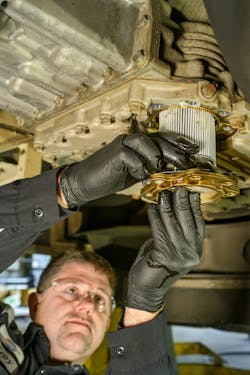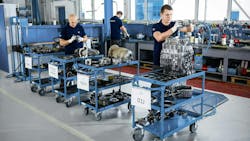How to equip fleets and technicians for transmission troubles
This is Part Two of a two-part story. Click here to read Part One.
As transmissions have grown more technologically advanced, some fleets and shops have found themselves playing catch up with these components and the hundreds of fault codes they can generate. In Part One of this story, we discussed some of the common issues modern transmissions may face and how to deduce the source of a transmission issue using diagnostic fault codes and dashboard lights.
In Part Two, here's how to leverage customer relationships to make sure shops are collecting as much information as possible, and then how to equip your techs, drivers, and fleet managers to prevent transmission problems in the future.
Customer communication
Knowing that transmission issues can manifest in different ways, the first step a technician should take before the customer even leaves the shop is to gather as much information as possible regarding the problem, along with any external factors that could have had an impact on the vehicle’s performance.
You want “complete details of the incident,” said Greg King, head of North American Transmission Service at ZF Group, “including noises heard, vehicle reactions, driving conditions, route conditions, smells, etc.”
Even things that may seem inconsequential can impact the performance of transmission components and might be relevant information for a tech to find out before beginning troubleshooting. For example, driving in extreme weather conditions, temperatures, elevations, or terrains can put additional stress on transmission components, leading to malfunctions or accelerated wear that wouldn’t have occurred otherwise.
Technicians should also inquire about the specifics of when the driver noticed a problem, as that could impact the severity or cause of the issue. Gary Burns, Allison Transmission’s director of customer support and channel development for North America, explained that “it’s helpful for the driver to note specific operating conditions, including if the vehicle is loaded or unloaded, operating at full throttle or part throttle, if the vehicle is at the beginning of the drive cycle or after some amount of drivetime, traveling at high speed or low speed, etc.”
Joe Scarnecchia, powertrain sales manager for Mack Trucks, also mentioned that it’s important to inquire about any work that may have been done on the truck before the issue started.
Knowing that there’s a long list of potential factors that can contribute to a transmission problem means that any detective work a tech can do before the customer leaves the shop is going to help them locate the problem once they get hands-on with the vehicle. Including a standard set of questions or a checklist in the intake process is a great way to ensure that techs are getting as much relevant information as possible before troubleshooting.
Equipping techs for tomorrow
When the customer leaves the shop, that’s when the real work begins. Before actively troubleshooting a transmission, most would suggest doing your research. Gary Pfister, Eaton’s N.A. technical services manager, said that understanding what you’re working with is half the battle, so if you’re not positive, take a moment to figure it out. He suggested taking advantage of online material, like the manufacturer website, among other options.
“Every product has a diagnostic tool associated with it. Learn it, understand how that tool works,” he said. “That tool can be your friend or your foe, so it’s really important for the technician to understand what tools [are in their] toolbox.”
In discussing Allison’s troubleshooting processes, Burns stressed that adhering to OEM recommendations is always the best course of action.
“A lot of time and effort is poured into the development and refinement of Allison’s troubleshooting processes,” he said. “Avoid skipping steps in the process or making assumptions. This can cause you to miss key details or clues that will help identify an issue.”
A basic understanding of the transmission you’re working with and any brand specifics is a good place to start, and checking the transmission controller for any fault codes is the next logical step, according to Alex Reid, vocational marketing manager at Kenworth.
“The brand of the transmission will determine which specific tool to use, but the process is the same,” he explained. “An external visual inspection of the transmission system and surrounding components may also provide useful diagnostic information.”
King seconded this step, stating that the “OEM diagnostic tool must be connected to read trouble codes and enable the use of the OEM troubleshooting trees.”
He also mentioned that if the vehicle is drivable, a test drive is necessary to try to replicate the issue. This can allow an experienced tech to better understand what’s happening and where to start when it comes to identifying the root cause.
Read more: 2024 Work Truck Update: Vans, pickups, and chassis cabs
King concluded by highlighting the importance of taking it slow when it comes to the troubleshooting process. “Modern electronic systems are very complex, and while they expedite troubleshooting, they can also create complex errors in the vehicle systems,” he said. “The previous inclinometer example illustrates how complexity can impact engines and transmissions; there are many sensors in the vehicle the technicians must keep in mind during the troubleshooting process.”
Ongoing training is going to be a key aspect in ensuring that techs are informed and able to handle whatever comes through the bay doors, especially considering the technological evolution set to come in the following years. The complexity of modern electric systems is already an obstacle for newer techs, and it seems as though fleet vehicles, equipment, and the tools used to service them will only get more convoluted as impending emissions regulations mandate new fuel types, and the corresponding technology advances to accommodate them.
Many newer transmissions may also offer “different drive modes that will give you a selection of engine torque and how the transmission shifts. These different options may affect how the engine and transmission performs,” Mack’s Scarnecchia explained. “Make sure to review the chassis specs, features, and options. The bottom line is to make sure that you actually have an issue before going into in-depth troubleshooting, because the engine and transmission may be working as they were engineered.”
Preventive measures
Not all transmission problems can be prevented ahead of time, as is the nature of unexpected issues, but there are some steps that can be taken to protect your fleet.
For fleet managers, encouraging and enforcing good driving habits and behaviors can go a long way toward keeping your vehicles’ transmission components in better shape for a longer period of time.
King discussed the importance of driver education and training to prevent component abuse, highlighting reckless driving, off-highway use with an on-highway application, and exceeding the vehicle load capacity as some specific practices that can negatively impact transmission health (not to mention fuel efficiency).
Manual transmissions are especially susceptible to “issues from abusive operation, and see a larger variation from driver to driver,” according to Reid. The skill level of the operator when it comes to shifting, and the precision required to do so, can leave a much larger window for things to go wrong than with automatic or even AMTs.
Staying on top of OEM recommended maintenance practices and scheduling periodic inspections can also be instrumental in warding off potential issues, or discovering them before they take your truck out of commission.
Reid explained that on the driver side, it’s crucial to know how your vehicle is supposed to behave and what phenomena could indicate a problem.
“Some transmission behavior is intentional for performance or fuel economy reasons,” he said, offering neutral coast as an example. “Read and understand the operator information to stay up to date on what is normal and what isn’t.”
A collaborative effort
All this being said, it’s evident that the best way to avoid the majority of transmission issues and the unplanned downtime that comes with them is a collaborative effort between fleets, OEMs, and techs.
Troubleshooting specifics and best practices will undoubtedly continue to evolve with transmission technology in the years to come, but the basics remain. Take your time, know what tools you have at your disposal, and consider all the possibilities that could be at the root of transmission problems.
Pfister concluded with one main piece of advice for technicians: “Get to know the product.” Troubleshooting guides, driver’s guides, and service manuals are all out there and at a technician’s disposal. “You’ve got to want to read it and understand it,” he said. “If you want to move forward with whatever you’re doing, you have to be educated about it before you do it.”
About the Author

Lucas Roberto
Lucas Roberto is an Associate Editor for Fleet Maintenance magazine. He has written and produced multimedia content over the past few years and is a newcomer to the commercial vehicle industry. He holds a bachelor's in media production and a master's in communication from High Point University in North Carolina.


